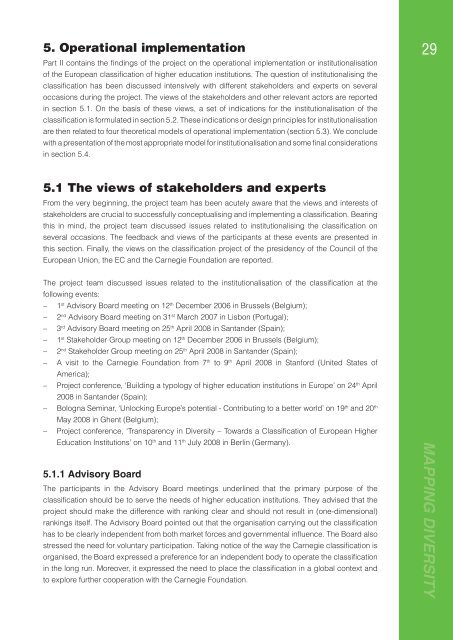Mapping Diversity: Developing a European Classification of ... - U-Map
Mapping Diversity: Developing a European Classification of ... - U-Map
Mapping Diversity: Developing a European Classification of ... - U-Map
You also want an ePaper? Increase the reach of your titles
YUMPU automatically turns print PDFs into web optimized ePapers that Google loves.
5. Operational implementation<br />
Part II contains the fi ndings <strong>of</strong> the project on the operational implementation or institutionalisation<br />
<strong>of</strong> the <strong>European</strong> classifi cation <strong>of</strong> higher education institutions. The question <strong>of</strong> institutionalising the<br />
classifi cation has been discussed intensively with different stakeholders and experts on several<br />
occasions during the project. The views <strong>of</strong> the stakeholders and other relevant actors are reported<br />
in section 5.1. On the basis <strong>of</strong> these views, a set <strong>of</strong> indications for the institutionalisation <strong>of</strong> the<br />
classifi cation is formulated in section 5.2. These indications or design principles for institutionalisation<br />
are then related to four theoretical models <strong>of</strong> operational implementation (section 5.3). We conclude<br />
with a presentation <strong>of</strong> the most appropriate model for institutionalisation and some fi nal considerations<br />
in section 5.4.<br />
29<br />
5.1 The views <strong>of</strong> stakeholders and experts<br />
From the very beginning, the project team has been acutely aware that the views and interests <strong>of</strong><br />
stakeholders are crucial to successfully conceptualising and implementing a classifi cation. Bearing<br />
this in mind, the project team discussed issues related to institutionalising the classifi cation on<br />
several occasions. The feedback and views <strong>of</strong> the participants at these events are presented in<br />
this section. Finally, the views on the classifi cation project <strong>of</strong> the presidency <strong>of</strong> the Council <strong>of</strong> the<br />
<strong>European</strong> Union, the EC and the Carnegie Foundation are reported.<br />
The project team discussed issues related to the institutionalisation <strong>of</strong> the classifi cation at the<br />
following events:<br />
st<br />
− 1 Advisory Board meeting on 12 th December 2006 in Brussels (Belgium);<br />
nd<br />
− 2 Advisory Board meeting on 31 st March 2007 in Lisbon (Portugal);<br />
rd<br />
− 3 Advisory Board meeting on 25 th April 2008 in Santander (Spain);<br />
st<br />
− 1 Stakeholder Group meeting on 12 th December 2006 in Brussels (Belgium);<br />
nd<br />
− 2 Stakeholder Group meeting on 25 th April 2008 in Santander (Spain);<br />
th<br />
− A visit to the Carnegie Foundation from 7 to 9 th April 2008 in Stanford (United States <strong>of</strong><br />
America);<br />
th<br />
− Project conference‚ ‘Building a typology <strong>of</strong> higher education institutions in Europe’ on 24 April<br />
2008 in Santander (Spain);<br />
th<br />
− Bologna Seminar, ‘Unlocking Europe’s potential - Contributing to a better world’ on 19 and 20 th<br />
May 2008 in Ghent (Belgium);<br />
− Project conference, ‘Transparency in <strong>Diversity</strong> – Towards a Classifi cation <strong>of</strong> <strong>European</strong> Higher<br />
Education Institutions’ on 10 th and 11 th July 2008 in Berlin (Germany).<br />
5.1.1 Advisory Board<br />
The participants in the Advisory Board meetings underlined that the primary purpose <strong>of</strong> the<br />
classifi cation should be to serve the needs <strong>of</strong> higher education institutions. They advised that the<br />
project should make the difference with ranking clear and should not result in (one-dimensional)<br />
rankings itself. The Advisory Board pointed out that the organisation carrying out the classifi cation<br />
has to be clearly independent from both market forces and governmental infl uence. The Board also<br />
stressed the need for voluntary participation. Taking notice <strong>of</strong> the way the Carnegie classifi cation is<br />
organised, the Board expressed a preference for an independent body to operate the classifi cation<br />
in the long run. Moreover, it expressed the need to place the classifi cation in a global context and<br />
to explore further cooperation with the Carnegie Foundation.<br />
MAPPING DIVERSITY

















